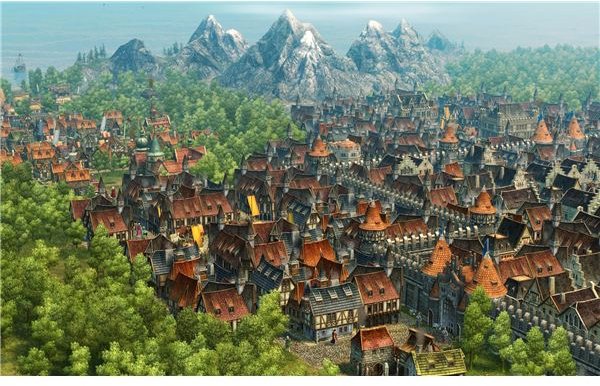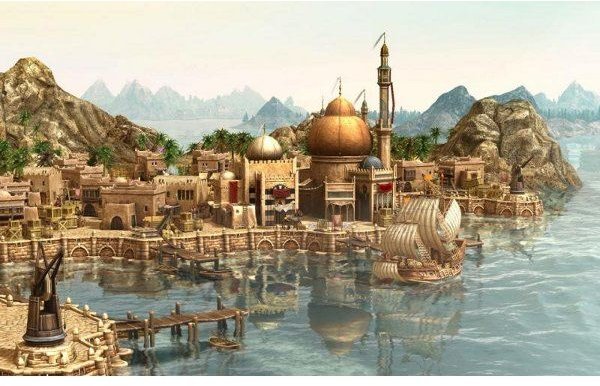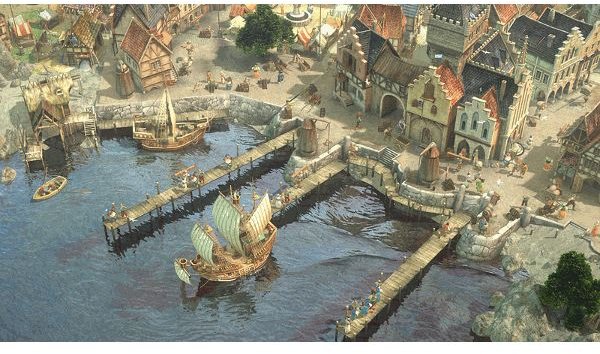Dawn of Discovery Economy Guide

Dawn of Economy
Dawn of Discovery is essentially an economic strategy game which bridges the gap between Sim City and Starcraft. Creating a strong economy in Dawn of Discovery requires a careful understand of both the tax income you’re receiving and the production chains of the resources you need. As a result, Dawn of Discovery is know to have a steep learning curve.
This guide will help you get on your feet. It covers money and resources, the two major elements of your economy which you need to learn how to balance.
The Basics of Money
As you might expect, money is important in Dawn of Discovery. Money comes from your taxes which are collected from your population. It can also be gained by selling goods to other cities. It is a global resource, so all taxes that are taken in from all of the islands you colonize contribute to one big pot. Money is treated as something of an ethereal resource in the game. You never transport it or see it on the map. It is simply a number on the interface.
The challenge with money is balancing the amount of money you’re bringing in through taxes and trade with the amount of money which you spend both purchasing buildings and ships and also the money you spend maintaining buildings and ships. This seems simple enough at first, but because you need certain resources to keep your people happy it often isn’t as simple as it sounds. Producing the resources needed to satisfy your populace without going bankrupt from the upkeep of the required buildings is a constant challenge.
Income Sources
There are four classes of people who live in your city - peasants, citizens, patricians, and nobles. The upper classes bring in more income per person than the lower classes. The best way to boost your income, generally speaking, is to make sure conditions exist which allow for your existing houses to level up to the next class. If that isn’t possible or your houses are already as leveled as they can be then your best option is to build more houses. Don’t waste the space around your market. If you build a marketplace, then make sure that you can use every inch of space around it for houses.
Trade can also be a source of income. For example, if you have control of many large ore deposits which make it easy for you to produce large quantities of tools and weapons you can capitalize on that by selling excess tools and weapons at foreign ports. This usually isn’t a major source of income, but it can be significant if you happen to have large amounts of a valuable resource.
Balancing the Budget

Balancing the budget requires constant attention to how much you’re making. Dawn of Discovery thankfully makes this easy by including a small balance sheet which expands when you click on the part of the interface which shows how much money you have. The expanded balance sheet shows you how much you’re making from taxes, how much you’re spending on building upkeep, how much you’re spending on ship upkeep, and how much you’re losing to beggars (if any live in your city).
Remember that EVERY building you build MUST be balanced by additional income. This is a fundamental rule of Dawn of Discovery and once you understand this you’ll find the game much easier to play. Let’s say, for example, that you’re going to build some ropeyards to build rope for your ships. You want to build two more. That’s 80 gold of extra upkeep, so you’ll either need to build a few more houses or you’ll need to upgrade some of your population to a higher class.
If you do find yourself in trouble with a budget rapidly spiraling out of control, don’t be afraid to destroy some buildings. It is never good to have to take down some of your buildings because you can no longer afford them, but its better than having no money, which will basically end your game.
Resources

Resources, unlike money, are a tangible asset in Dawn of Discovery. Resources are kept in warehouses on your islands. They are also specific to each island rather than global. The resources that you’ve collected on each island can only be transferred by using a ship to move them back and forth.
Running out of resources can also be a big problem depending on what the resource is. Some resources, like stone, can go empty without major consequences. You’ll no longer be able to build things which need stone, but that’s the only consequence. Running out of fish, on the other hand, means your people will begin to starve. They’ll move out of houses and will eventually begin to riot.
Resources are also gained in different ways. Some resources are raw resources. These are things like stone and fish. All you need to do to obtain these is build a building in the correct place, such as by a stone deposit or on a shore. Other resources are produced resources. Bread, for example, requires that you first create a crop farm to harvest wheat, than a mill to process it into flour, then a bakery to bake the flour into bread.
Production Chains

This process is called a production chain. A production chain is a chain of operations which must happen in order to convert raw resource into produced resources.
Production chains should generally be set up in a common area. The reason for this is that production buildings have a certain radius in which they can interact with other buildings by using journeymen to retrieve resources. Let’s say, for example, that you build a mill right next to the crop farm. Journeymen will automatically move the wheat produced by the crop farm to the mill. Now let’s say you build the bakery on the other side of the island. The bakery can still operate, but flour from the mill will have to be brought to the bakery by a market cart. That takes much longer and slows down the entire chain of production.
Creating these production chains is a fundamental part of Dawn of Discovery. It takes some getting used to, and you have to be careful with how you place your buildings so you don’t accidentally break your production chain. The area of effect in which each building can interact with others is clearly marked when you place a building, so pay attention to it.
Slow but Steady
These are the basics of your economy, but of course balancing Dawn of Discovery’s complex resource system is easier said than done. As a new player you should expect to mess up a few times.
Have patience, however, and you’ll get the hang of things. Just don’t try to expand too quickly. This is where many new players get into trouble. Remember that increasing your population is going to put a greater strain on your resources and that increasing your resources is going to put a greater strain on your money. It is easy to let this get out of control if you plop down twenty new houses in one go. Take it easy, build in small steps, and you shouldn’t have any problems.
This post is part of the series: Dawn of Discovery Guide
Dawn of Discovery is a complex and daunting game to learn, but incredibly rewarding once you understand how it works. This guide will help you play Dawn of Discovery and enjoy this beautiful city builder.
